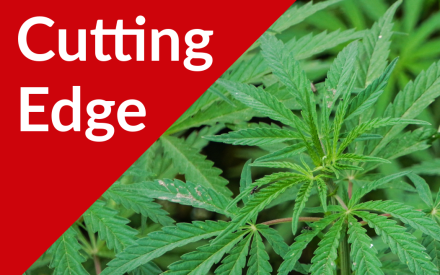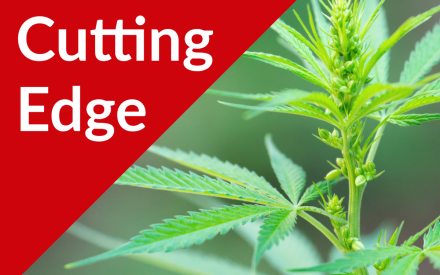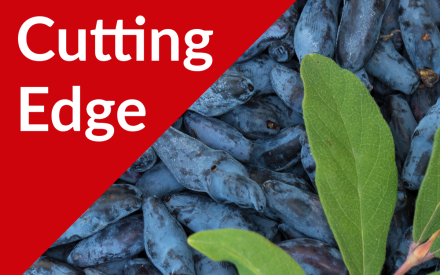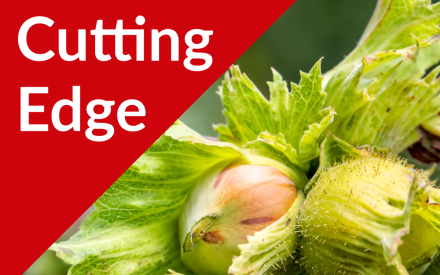Forrest Funmaker of the Ho-Chunk Nation talks about the significant of their partnership with UW-Madison to conduct hemp variety trials at Whirling Thunder Farm near Tomah, Wisconsin. The partnership is made possible by a Sustainable Agriculture and Research Education (SARE) grant.
Forrest Funmaker is the Agricultural Researcher and Education Manager of the Ho-Chunk Nation at Whirling Thunder Farm.
Transcript
JASON FISCHBACH 0:00
This is a podcast about new crops. You’re gonna love it. Join us on The Cutting Edge, a podcast in search of new crops for Wisconsin.
Steffen Mirsky 0:10
This episode was recorded back in early July of 2022. But we never got around to posting it. It ties in nicely with our previous episode on hemp research updates, so I thought I’d post it now. It’s a little glimpse into UW extensions partnership with the Ho-Chunk Nation for its hemp variety trials. My co-host Jerry Clark interviews Forrest Funmaker of the Ho-Chunk nation during a field day at their Whirling Thunder Farm. I hope you enjoy.
Jerry Clark 0:49
Alright, thanks for hosting us today on the property here. It’s part of a UW-Madison Division of Extension on-farm research trial that were part of a Sustainable Agricultural Research and Education grant that we received and we’re doing these, this project in three different locations around the state one here at the Ho-Chunk Nation. We’re just, what, southwest of Tomah a little bit?
Forrest Funmaker 1:12
Yeah.
Jerry Clark 1:12
And then we’ll we have another one in Buffalo County, and another one up in Chippewa County. So it’s been a project we worked on for several years and forest, what brought the attention to the Ho-Chunk nation to get involved in this?
Forrest Funmaker 1:26
Yeah. Oh, yeah. Well, the Ho-Chunk Nation, I think, has been involved with agriculture for quite some time, they recently as a tribe, kind of got away from some of the growing practices. But here at Whirling Thunder Ranch, they did put in eight acres of organic lands. And so with the new administration under President Marlon WhiteEagle, he wanted to make sure that all of these kinds of ventures were looked at once again. And so I think the partnership between the UW system, and the Ho-Chunk Nation is one that he wanted to explore, as part of the, I think the attraction, trying to set something up here with industrial hemp. And with food sovereignty, these are a couple of the big things that have become really important to the Ho-Chunk people in the different communities. And we wanted to see how our lands would compare to others, and then to see how to build those relationships with outside entities that do formulate some of those expert things that have been in the field for quite some time. And I think the capacity that the nation is trying to look for in terms of how to integrate these kinds of crops into their rotation, or certain locations that we do have. And I’m I’m not sure if you know this, Jerry, but the Ho-Chuck Nation, and I don’t want to go on a big, big history kind of thing, but we were removed seven times, militarily from Wisconsin, came back each time to find our homelands once again, and so this is a part of our experiment to reclaim stuff. And so it’s a pretty cool process to get that knowledge back and combine it with our language, and then how to see if we can get into any kind of manufacturing, and see if that has any applicability to what we can do in the future.
Jerry Clark 3:42
Yeah, and that’s what I was wondering. So in part of the project we have out here is related to looking at varieties. And Steffen, I think we were looking at some fertilizer management out here as well, correct?
Steffen Mirsky 3:55
Yeah, we’ve just applied some potash and nitrogen to each of the varieties.
Jerry Clark 4:03
Yeah, so then, Forrest when we get some of this growing and research, this is our second or third year (second) year involved with the Ho-Chunk Nation. So you mentioned manufacturing, how will we bring in that? What’s the what’s the goal or the plan of maybe being able to use for what we’re learning here to advance some of that manufacturing?
Forrest Funmaker 4:29
Again, I think the Ho-Chunk Nation wants to be a leader in conservation, and also with what we can do to help the environment. And this is one of those kinds of avenues to explore. I know, looking at some of the scientific research with corn and turning it into plastics and how to have not such a big waste crop, the cycle of goods and services that go to the regular public or regular consumer? What would we want to do with? Let’s say we got floorboards or cabinetry made from industrial hemp? How would that be manufactured at the Ho-Chunk Nation? And if we were to invite industry to be a part of what we do, how would that partnering kind of result and and then we would have this kind of research to say it’s not blindsiding us or t-boning us from the side and we don’t know what’s going on. But we actually have all of this data that would be shared with our people and bringing them along as well.
Jerry Clark 5:44
Yeah, with a new crop like industrial hemp that was approved, I think 2018, so 2019 I believe was the first year we did any kind of legal planting of industrial hemp. And trying to bring that part of, of I think for once the university system seems to be ahead of the curve on a crop where let’s get some data before the industry takes off. And you’re a big part of that, because we’re looking at different locations, different partnerships. And I think the industry as we move forward is where the challenge might be is that manufacturing part and having a partnership with the Ho-Chunk Nation, I think advances that a lot quicker because we have an outside partner that’s really looking at that process and part of it.
Forrest Funmaker 6:29
Yeah, for sure. And I don’t know if we have enough land for all of the things that we want to do with the manufacturing part. But at least I think that we would be essential to the idea of adding our two cents to the whole equation of what’s sustainable, and how the state should be going with the use of this particular crop. So we’re, we’re excited.
Jerry Clark 6:57
So one thing that Extension is looking at in terms of this project, and then we get the data from the three locations, and then Steffen, you’re going to be a big part of our outreach to the public, as far as publications, website, kind of that kind of stuff, you got, I know you’ve only been on the job maybe a month or two at the most. You got any plans where we’re headed with some of the media or at least the outreach part of getting our information out?
Steffen Mirsky 7:26
Well, we’re trying to establish a network right now across the state. So just just to get a feel for who all is involved in the supply chain from growing the plants, you know, the producers, processors to, you know, all the way to, to retailers and consumers. So yeah, just trying to get a feel for that. And to bring those people together so that we can start developing the markets.
Jerry Clark 8:01
Yeah, yeah. So I think that’s a key part, like you said, the outreach, identifying who’s actually out there growing industrial hemp. We know there’s a few of us out here doing this. But that’s part of it. How can how can we reach the local agents are yourself as far as some of the contact if someone has a crop looking for an outlet for the crop? Where do we go with just kind of that that partnership directory type of thing? Right?
Steffen Mirsky 8:31
Yeah. I think there’s a lot of people working individually, without knowing where to sell their product, or where to buy their product if they’re a retailer. And so I think bringing the people together, and just establishing a statewide network is just really important going forward for building the market.
Jerry Clark 8:55
Great. Yeah. And I think that the Ho-Chuck Nation, being a major partner of it. And just Chippewa County, we’ve had Economic Development Corporation, kind of looking at it, those kinds of things. So part of this podcast, the reason we do these series is for subscribers, to spread the word that, you know, we’re looking into these partnerships, if there’s any industry manufacturers out there, but the Ho-Chunk Nation is at least at the at the leading edge of it as far as looking at possibly getting into the, the processing part and then knowing how to grow it, which is what we’re trying to do here today is to develop that that agronomic background as far as varieties and fertility and those kinds of things. So, Forrest, you were a big part of of implementing this a few weeks ago driving tractor and yeah, getting the planter all rigged up. Has the Ho-Chunk Nation been part of these kinds of research projects in the past or been partnering with?
Forrest Funmaker 9:51
I would say not. I know we did have some previous things with AmeriCorps but the whole idea of trying to get industrial with or even commercial with our growing is something quite new. Because one of the things is we’ve never had like that kind of farm ranch mentality. It’s mostly been for subsistence type of farming. And so getting into this realm is a whole new adventure. For some of us, especially from a tribal perspective, and there may have been individuals who are farmers or whatever. But in terms of where we’re going, or where we could head in terms of being a part of the market, I know Menominee did try to do some of these things previously, and I think they wanted to get into like some CBD oil or, or any kind of that sort of growing. So it’s interesting that our sister tribe down in Nebraska now has a full thing of cannabis growing. And I want to see how that all kind of turns out as well. Because if we can get a satellite kind of thing from their institution up here, so we can get some sort of meritocracy going and have people that are certified in different parts of the production process. I think it’ll be really good for the nation to be able to make those kind of real world decisions, how to do this kind of stuff.
Jerry Clark 11:32
So you think part of that goal might be to expand acreage, if something like industrial hemp would take off? Or if it’s a different crop, is that kind of that connection with sister tribes?
Forrest Funmaker 11:41
Yeah, for sure. They I think they’ve got about 12,000 acres. And we’re at about 1600 Here in this in Wisconsin. And so I think the only thing that we’re kind of leery about is the use of pesticides and herbicides and those kinds of things that may affect the environment, because I said that’s that’s the hard part for us, especially with this particular farm, is that we want to be as neutral as possible about those kinds of things and how they can affect affect the environment.
Jerry Clark 12:19
That is a great point. This is an organic location here, that we’re using organic practices, as far as weed control is mainly tillage or a hoe or garden weasel, or whatever you got in the field, so yeah, that’s the challenge I think with a site like this, is not only just learning a new crop, but then trying to grow it under an organic system where we got a lot to learn about the the cropping system, you know, what previous crop might work better versus no-till or whatever. So yeah, we’re all learning along the curve.
Forrest Funmaker 12:56
Really? Okay, I didn’t know that. I thought you guys were miles ahead of us so this is kind of surprising.
Jerry Clark 13:01
Um, not from an organic standpoint, we’re still this is this is going to be all new, new frontier as far as that goes.
Forrest Funmaker 13:08
So last year, when the project was here, it was located at a different location on the ranch. We were told, from some of the results that we had some of the best row from the varieties that were introduced. So we were, we were really excited to hear that.
Jerry Clark 13:28
Yeah, we were down here last year for the field day and and all the varieties down here were much taller and robust than they were in Chippewa County. And again, this is more of a silt loam type soil down here and in Chippewa County was a little more sand. So we’ve tried purposely to find locations that we could, you know, challenge some of these varieties a little bit as far as soil type. So yeah, that was down here. And it was pretty impressive what you were able to grow here. So we know we’re on the right track as far as what it does. Well, and if you’re on a sandier soil, you probably need a little more water, or at least keep that fertility level up. Yeah. So yeah, from that standpoint, I think we really appreciate you giving us a little bit of time today for us that you don’t want us out with the project. And Steffen, welcome aboard and I know we’ll be hearing more from you on these Cutting Edge podcasts. And from that standpoint, if you have any questions regarding our projects, with industrial hemp, you feel free to contact us with the county UW Madison Division of Extension county offices. You can sure reach Forrest is there a better way to reach you forest people got some
Forrest Funmaker 14:36
They can just go on to the website of the Ho-Chunk Nation, it’s www.ho-chunknation.com, and look for DNR. If not, they can just ask for my number or my extension through the main…
Jerry Clark 14:52
Through the main directory then. Great. Sounds good. So Steffen, any final thoughts on what we’re doing out here? Know you’re new to the game, but first impressions.
Steffen Mirsky 15:04
I’m excited to come back out here later in the summer and see the stand when it’s a few feet taller. Just looking forward to continuing this partnership.
Forrest Funmaker 15:13
I know I was so impressed when I came out today and I seen you know how much had come up within the last few weeks? Just two weeks ago, right? Yeah, it was just amazing. I was like, wow, this is this is gonna be awesome. Yeah, I can’t wait to see the results of it.
Jerry Clark 15:27
And it’s great point. We’ll be back out for more Cutting Edge podcasts from this location to see how things are going and we’ll keep evaluating this as we go along again, Forrest Funmaker. Appreciate you joining us today as well as Steffen. Welcome aboard.
JASON FISCHBACH 15:39
Brought to you by the University of Wisconsin Madison Division of Extension
Transcribed by https://otter.ai


 The Cutting Edge Podcast Episode #53: Hemp Research Priorities at UW-Madison with Dr. Shelby Ellison
The Cutting Edge Podcast Episode #53: Hemp Research Priorities at UW-Madison with Dr. Shelby Ellison The Cutting Edge Podcast Episode #52: Update on State and Federal Hemp Regulations
The Cutting Edge Podcast Episode #52: Update on State and Federal Hemp Regulations The Cutting Edge Podcast Episode #51: Honeyberry Production
The Cutting Edge Podcast Episode #51: Honeyberry Production The Cutting Edge Podcast Episode #50: UMHDI Hazelnut Breeding Updates
The Cutting Edge Podcast Episode #50: UMHDI Hazelnut Breeding Updates


